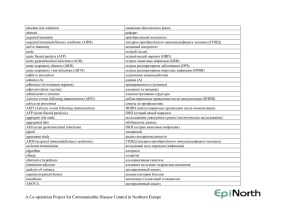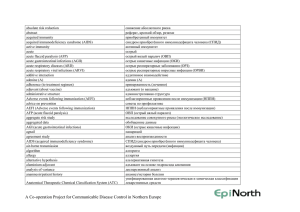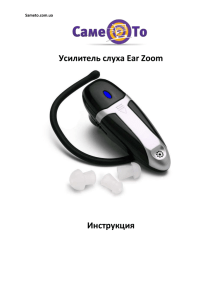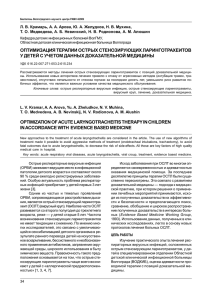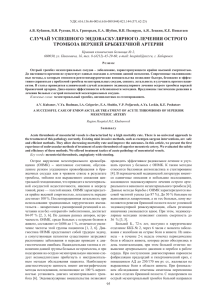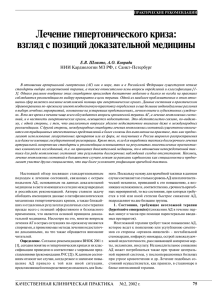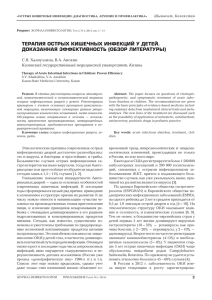Выписной эпикриз история болезни №18374
реклама
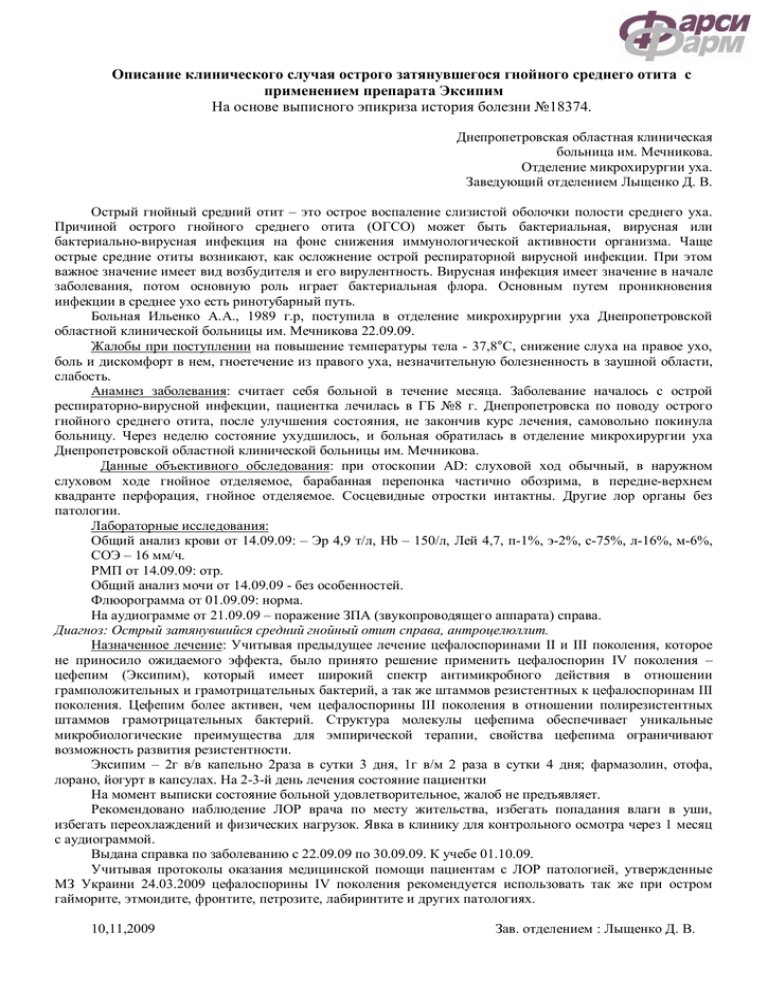
Описание клинического случая острого затянувшегося гнойного среднего отита с применением препарата Эксипим На основе выписного эпикриза история болезни №18374. Днепропетровская областная клиническая больница им. Мечникова. Отделение микрохирургии уха. Заведующий отделением Лыщенко Д. В. Острый гнойный средний отит – это острое воспаление слизистой оболочки полости среднего уха. Причиной острого гнойного среднего отита (ОГСО) может быть бактериальная, вирусная или бактериально-вирусная инфекция на фоне снижения иммунологической активности организма. Чаще острые средние отиты возникают, как осложнение острой респираторной вирусной инфекции. При этом важное значение имеет вид возбудителя и его вирулентность. Вирусная инфекция имеет значение в начале заболевания, потом основную роль играет бактериальная флора. Основным путем проникновения инфекции в среднее ухо есть ринотубарный путь. Больная Ильенко А.А., 1989 г.р, поступила в отделение микрохирургии уха Днепропетровской областной клинической больницы им. Мечникова 22.09.09. Жалобы при поступлении на повышение температуры тела - 37,8°С, снижение слуха на правое ухо, боль и дискомфорт в нем, гноетечение из правого уха, незначительную болезненность в заушной области, слабость. Анамнез заболевания: считает себя больной в течение месяца. Заболевание началось с острой респираторно-вирусной инфекции, пациентка лечилась в ГБ №8 г. Днепропетровска по поводу острого гнойного среднего отита, после улучшения состояния, не закончив курс лечения, самовольно покинула больницу. Через неделю состояние ухудшилось, и больная обратилась в отделение микрохирургии уха Днепропетровской областной клинической больницы им. Мечникова. Данные объективного обследования: при отоскопии AD: слуховой ход обычный, в наружном слуховом ходе гнойное отделяемое, барабанная перепонка частично обозрима, в передне-верхнем квадранте перфорация, гнойное отделяемое. Сосцевидные отростки интактны. Другие лор органы без патологии. Лабораторные исследования: Общий анализ крови от 14.09.09: – Эр 4,9 т/л, Нb – 150/л, Лей 4,7, п-1%, э-2%, с-75%, л-16%, м-6%, СОЭ – 16 мм/ч. РМП от 14.09.09: отр. Общий анализ мочи от 14.09.09 - без особенностей. Флюорограмма от 01.09.09: норма. На аудиограмме от 21.09.09 – поражение ЗПА (звукопроводящего аппарата) справа. Диагноз: Острый затянувшийся средний гнойный отит справа, антроцелюллит. Назначенное лечение: Учитывая предыдущее лечение цефалоспоринами ІІ и ІІІ поколения, которое не приносило ожидаемого эффекта, было принято решение применить цефалоспорин IV поколения – цефепим (Эксипим), который имеет широкий спектр антимикробного действия в отношении грамположительных и грамотрицательных бактерий, а так же штаммов резистентных к цефалоспоринам III поколения. Цефепим более активен, чем цефалоспорины III поколения в отношении полирезистентных штаммов грамотрицательных бактерий. Структура молекулы цефепима обеспечивает уникальные микробиологические преимущества для эмпирической терапии, свойства цефепима ограничивают возможность развития резистентности. Эксипим – 2г в/в капельно 2раза в сутки 3 дня, 1г в/м 2 раза в сутки 4 дня; фармазолин, отофа, лорано, йогурт в капсулах. На 2-3-й день лечения состояние пациентки На момент выписки состояние больной удовлетворительное, жалоб не предъявляет. Рекомендовано наблюдение ЛОР врача по месту жительства, избегать попадания влаги в уши, избегать переохлаждений и физических нагрузок. Явка в клинику для контрольного осмотра через 1 месяц с аудиограммой. Выдана справка по заболеванию с 22.09.09 по 30.09.09. К учебе 01.10.09. Учитывая протоколы оказания медицинской помощи пациентам с ЛОР патологией, утвержденные МЗ Украини 24.03.2009 цефалоспорины IV поколения рекомендуется использовать так же при остром гайморите, этмоидите, фронтите, петрозите, лабиринтите и других патологиях. 10,11,2009 Зав. отделением : Лыщенко Д. В. Description of a clinical case of protracted othelcosis during which Exipime was applied On the basis of epicrisis, case report No. 18374. Mechnikov Regional Clinical Hospital of Dnipropetrovsk Department of Ear Microsurgery D.V. Lyshchenko, Head of the Department Acute othelcosis is acute inflammation of the mucosal tunic of the tympanic cavity. It can be caused by bacterial or viral or bacterial-and-viral infection against the background of low immunity. Acute othelcosis most often occurs as a complication of an acute respiratory viral infection. The causative agent and its virulence play an important role. A viral infection is significant at the early stage of the development of the disease, and later bacterial flora becomes more significant. The rhinotubal way is the main way for an infection to penetrate into the middle ear. Patient Ilienko А.А., born in 1989, was hospitalized to the Department of Ear Microsurgery, Mechnikov Regional Clinical Hospital of Dnipropetrovsk, on 22.09.09. Complaints when hospitalized: fever (37,8°С), hearing impairment in the right ear, pain and discomfort in the ear, purulent discharge from the right ear, moderate pain in the parotid region and general weakness. Case history: The patient considers herself to be sick for one month. The disease began from an acute respiratory viral infection. The patient received treatment for acute othelcosis at the City Hospital No.8, Dnipropetrovsk. When the patient’s condition improved she left the hospital being not permitted and without having the treatment completed. Her condition worsened in a week and the patient went to the Department of Ear Microsurgery, Mechnikov Regional Clinical Hospital of Dnipropetrovsk. Findings of physical examination (AD otoscopy): standard acoustic meatus, purulent discharge from the ear canal, the eardrum is partially visible, perforation in the anterosuperior quadrant, purulent discharge. The mastoid processes are intact. Other ENT organs without pathology. Laboratory tests: Complete blood count (14.09.09): RBC – 4.9, Нb – 150, WBC – 4.7, Ban – 1%, Eos – 2%, Seg – 75%, Lymphs – 16%, Mono – 6%, ESR – 16 mm/hour. Micro precipitation test (14.09.09): negative Clinical urine analysis (14.09.09): without peculiarities. Photofluorogram (01.09.09): normal. Audiogram (21.09.09): sound-conducting apparatus involvement on the right. Diagnosis: Protracted acute othelcosis on the right, auricular cellulitis. Prescribed treatment: Taking into account the previous treatment with 2nd and 3rd generation cephalosporins that did not result in the expected effect we decided to use Exipime (cefepime), a 4th generation cephalosporin, which has a broad-spectrum antibacterial action against both gram-positive and gram-negative bacteria and strains resistant to 3rd generation cephalosporins. Cefepime is more active against polyresistant gram-negative bacterial strains than 3rd generation cephalosporins. The structure of cefepime molecule provides unique microbiologic advantages for empiric therapy. Cefepime’s properties limit possible development of resistance. Exipime 2g iv drop-by-drop twice a day for 3 days, then 1g im twice a day for 4 days; Farmazolinum; Otofa; Lorano; and encapsulated yoghurt. Check of the patients’ condition on the 2nd-3rd day of treatment. The patient’s condition at the moment of discharge from the hospital was satisfactory. She did not have any complaints. Recommended: Local otolaryngologist’s supervision; avoidance of moisture in ears, supercooling and physical activity. Control examination at the clinic in a month (an audiogram should be brought). Medical certificate to confirm the person was sick from 22.09.09 to 30.09.09 is issued. The person may resume her studies from 01.10.09. Taking into accounts the health care protocols approved on 24.03.2009 by the Ministry of Health of Ukraine for patients with ENT pathologies 4th generation cephalosporins are recommended to treat for acute maxillary sinusitis, ethmoiditis, frontal sinusitis, petrositis, labyrinthitis and other pathologies. 10.11.2009 D.V. Lyshchenko, Head of the Department
